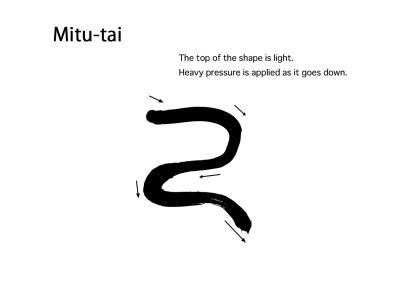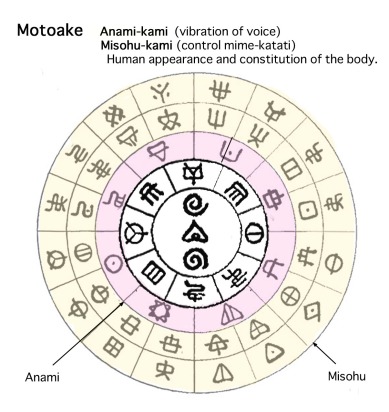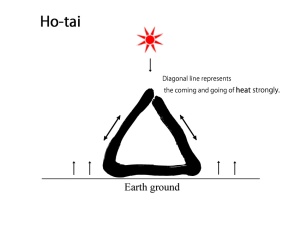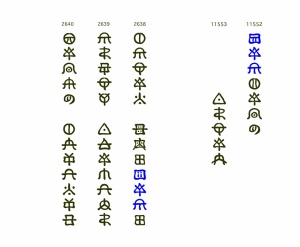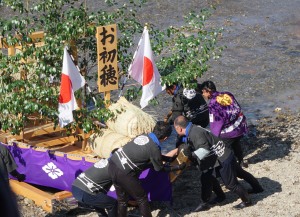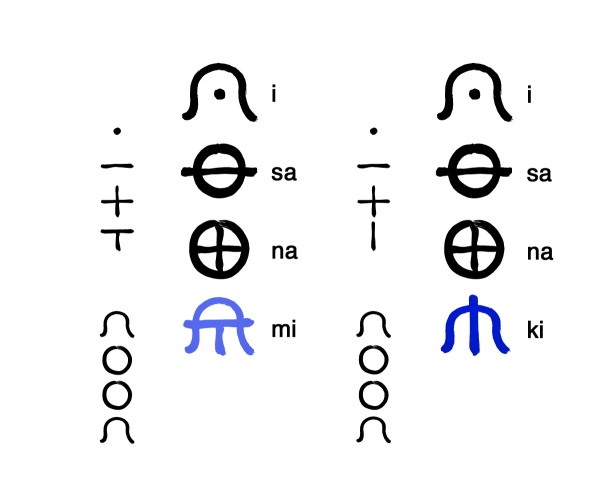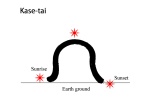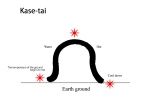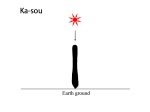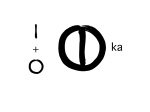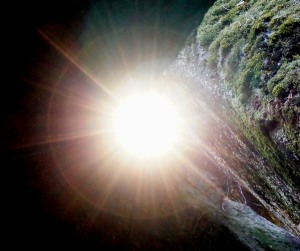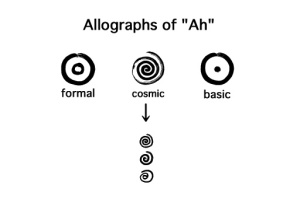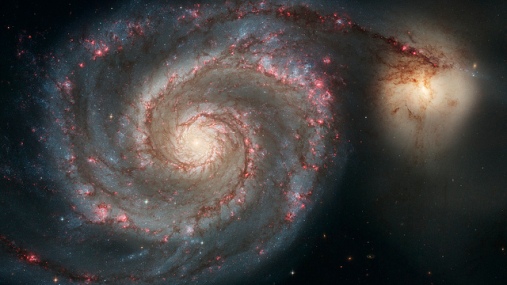
The above image of M51 Whirlpool Galaxy is by NASA and European Space Agency and is in the public domain. The Wosite chart in this article is by S. Sakata.
This article describes Wosite cosmogenesis, how Cosmos and Earth are created by primordial forces of Universe. While we show only one short passage, the insights expressed here have been derived from other passages in Wosite literature. It is quite difficult to render into contemporary English. It requires study and practice of esoteric and hidden teachings. It is our intention to offer our modest knowledge so that people everywhere may benefit from it.
Hotuma Tutae Ametuti Passage
There is a very profound description of the origination of Cosmos, Sun, Moon, and Earth, found in Hotuma Tutae lines 2576-2583. This passage in Wosite is reproduced above, as verse in rhythms of five and seven. Next, we present the voicing of the verse. As you read it out loud, please sound each syllable clearly and consciously.
ame tuti no hirakeru toki no
hi to iki ga: me wo to wakarete
wo ha ame ni, me ha tuti to naru.
wo no utuho kase umi, kase mo
ho to wakare. u wose no mune ha
hi no wa naru. i me no minamoto
tuki to naru. tuti ha hani mitu;
katu hani ha yama sato to naru.
Glossary for lines 2576-2585:
ame, cosmos, sun. tuti, earth. hirakeru, opening, separating in a natural way. toki, time. hi, first (when written as shown). iki, breath, will, mind. wakarete, divide. wo, male aspect of energy. me, female aspect of energy. naru, to become. utuho, ‘space’ energy of universe. kase, repetetive motion. umi, born. ho, fire (when written as shown). u, great. wose, male energy. mune, breath, origin, root. hi-no-wa, sun (when written as shown). i, will, mind, intent. minamoto, essence. tuki, moon. hani, soil without water; stabilized, fixed, determinate. mitu, energy moving, flowing. katu, moreover. yama, mountain. sato, plain.
The passage in Wosite & English:
At the time when Ame and Tuti separate,
first breath divides into a pair of Me and Wo.
Wo becomes Ame/Sun,
while Me becomes Tuti/Earth.
Wo no Utuho becomes very hot like Ho and produces Kase,
and Kase separates out Ho.
U-wose produces Hi-no-wa.
The essence of I-me becomes Tuki.
Tuti is made of Hani and Mitu.
And Hani makes mountains and plains.
Explanation:
With the first breath of origin, various phenomena occur. First Utuho Space energy divides into a pair of Male and Female energies. The Male energy being lighter, it becomes Sun and other celestial bodies. This is called Ame. Female heavy energy firmly solidifies and becomes Earth and Moon.
Kase comes from Male cosmic energy. Kase Wind energy is a regular occurrence, repetitive motion. It means that something is happening, regularly repeating. Although Kase is unseen, it implies the passage of time, and even more importantly, that time itself exists.
The part of Kase that moves vigorously at high temperature is called Ho, Fire energy. These three —Utuho, Kase, Ho — are always moving strongly, and are Male cosmic energy.
Sun from the Male was placed near Earth. Moon from the Female was placed closer to Earth. Life forms of people are comprised of inter-workings and characteristics of the five: Utuho/Space, Kase/Wind, Ho/Fire, Mitu/Water, Hani/Soil. Male energy of humans has Sun as its essence; Female will of humans has Moon as its essence.
The ground of Earth can be divided into Mitu and Hani. The hardened stable Hani makes the soil of mountains and fields. Water is a form of Mitu. The nature of Mitu is to increase as it flows, gathering while not changing its essence, and flows without stopping.
It is important to note that Space, Wind, Fire, Water, Soil, are not “things”; they are primordial energies with characteristic types of activity and therefore they represent processes. We may think in terms of gerunds: Soil hardening, Water flowing, Fire heating, Wind blowing, Space activating. Although this is rather simplistic, it is a start toward deeper understanding.
We suggest that you spend time sounding the vowels to feel their primal energies. Write Wosite vowels and imagine their deep meanings.
It seems to us best to use the original Wosite terms for the five energies, since they are so rich in meaning.
Ame and Tuti, Cosmos and Earth
This Wosite verse describes the separation of Uchuu into Ame and Tuti, Universe into Cosmos and Earth. It explains how Earth and Moon are created differently from the rest of the Cosmos.
Uchuu may be said to be Universe, if we agree that Universe is All That Is. The essence of Universe is energy. Primordial energies are the source of our Cosmos. These energies are Utuho, Kase, Ho, Mitu, and Hani. Because the original energy divided into Male and Female aspects, the five primordial energies also bear these aspects. Utuho, Kase, Ho are Male energies. Mitu and Hani are Female.
To most astronomers, cosmos and universe are practically synonymous. However to esoteric thinkers, they may not be exactly the same. We may say that astronomers study the cosmos, the observable universe. The word “cosmos” originally meant to ancient Greeks the orderly universe. We may think of planets, sun, stars, galaxies as being observable and orderly. In recent times, the presence of dark matter and dark energy has been discerned. Thus, the study of the cosmos by astronomers now includes invisible yet observable (through their effects) matter and energy. Let us agree to use the term “cosmos” to mean this kind of universe.
Ame is Cosmos, the universe of outer space: sun, stars, galaxies, … Ame/Cosmos is produced by primordial Male energies. Tuti/Earth, is produced by primordial Female energies. Ame is not identical to Uchuu. In our view, Cosmos is only a part of Universe.
In summary, Uchuu/Universe includes Ame/Cosmos and Tuti/Earth, as well as the laws and principles of Uchuu/Universe and its unseen energies.

Earth and moon, by NASA.
***
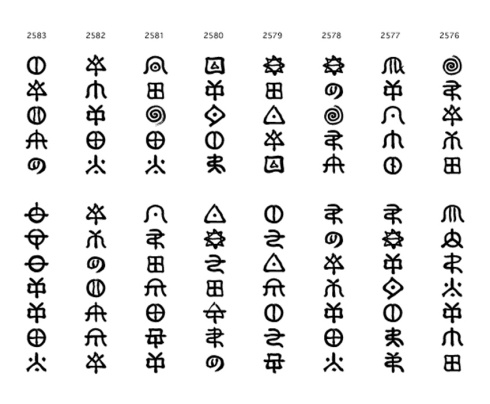




 Hani-tai, as its square shape indicates, is heat energy circulating in a stable manner. It means that it is getting dry and firm. The process of change is over and has been completed, as the image suggests.
Hani-tai, as its square shape indicates, is heat energy circulating in a stable manner. It means that it is getting dry and firm. The process of change is over and has been completed, as the image suggests.

